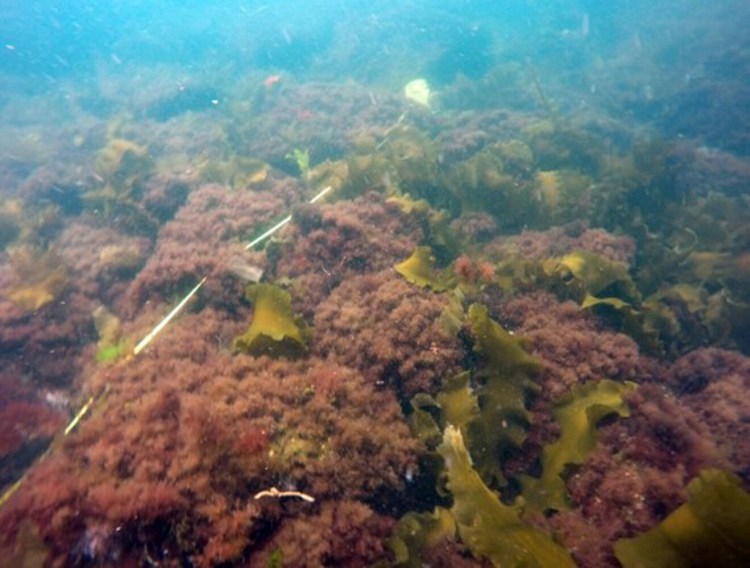Kelp – the tall, brown fronded seaweed that has traditionally dominated the Maine coast’s seafloor – is vanishing from southern Maine and seacoast New Hampshire as the Gulf of Maine warms, with far-reaching ecological implications scientists are scrambling to understand.
In the 1970s, Kelp and Irish moss accounted for nearly 80 percent of the seaweed cover on the seafloor off southern Maine, an area now dominated by low, scrubby, invasive seaweeds that account for more than 80 percent of the coverage, researchers at the University of New Hampshire have found.
“From Portland south, the water temperatures are not favorable for kelp, so this tufty, scrubby habitat is not going away,” says biological oceanographer Jennifer Dijkstra of the UNH Center for Coastal and Ocean Mapping, the lead scientist on several recent research studies into the change and its ecological implications. “Kelp provide habitat for fish, crabs and lobsters, so it is pretty important to know how commercial species might be effected.”
Like coral reefs in the tropics, kelp forests are what scientists call a “foundation species,” one that creates a physical habitat for everything else to live, feed and breed within.

This photo taken in the 1990s shows the tall blades of kelp seaweed that once dominated the ocean floor in the Gulf of Maine and offered protection for certain species of sea life. Larry Harris/ UNH
“They foster an enormous amount of local biodiversity, and there are many species that live only within them,” says Doug Rasher, a coastal ecologist who studies kelp forests for the Bigelow Laboratory for Ocean Sciences in Boothbay. “When you lose these forests, you lose all that.”
But kelp is a cold-loving organism living at the southern end of its range. When water temperatures get into the high 60s, kelp’s fronds and leaves fall apart, and encrusting, warm-water bryozoans smother them in white, calcified colonies. The forests collapse.
The Gulf of Maine is the second-fastest-warming part of the world ocean because human greenhouse gas emissions are melting down the Arctic, weakening the strength of the frigid Labrador Current that normally feeds the gulf and letting in pulses of warm Gulf Stream water instead. The kelp doesn’t like that one bit.

In a new study published this month in the journal Ecosphere, Dijkstra’s team found that warming water off York County and the Isles of Shoals has been squeezing the growing season for kelp, with the number of days when water temperatures exceed its tolerance growing by more than forty-fold since the 1980s. The shrubby invasive seaweeds that compete with them don’t mind the warmer water.
Her team took high-resolution underwater video of over 100 square miles of seafloor in several study sites between Cape Porpoise and the Isles of Shoals – an archipelago straddling the Maine-New Hampshire border 6 miles out to sea – allowing them to map seaweed cover in minute detail. The images showed not only that shrubby algae had taken over, but also that where they had there were fewer fish and larger areas lacking cover for fish to hide from predators.
“Kelp acts as a refuge for species like cunner and juvenile pollock and other fish, but these red, short, tufty seaweeds don’t provide much refuge,” she says. “These fish are probably more exposed to predation.”

A close-up view of a bed of kelp seaweed, which once dominated the sea floor in the Gulf of Maine. Jennifer Dijkstra/UNH
Researchers in Norway found that the number of small cod, haddock, pollock and other so-called gadid fish fell by 92 percent in areas where kelp forests were experimentally harvested, suggesting kelp probably help the same species in the Gulf of Maine. On Cashes Ledge, a submerged mountain range 80 miles southeast of Portland with a massive kelp forest, researchers from Brown University have found that the total fish mass density is 305 times greater than at sites around the Isles of Shoals, where kelp has largely disappeared.
“Losing them is like losing a forest on land,” says Jon Witman, a Brown University marine ecologist who has studied the Cashes Ledge kelp since 1977. “The birds disappear.”
The good news is that as you move east of Portland, water temperatures are still favorable for kelp.
“Kelp forests in the York area and Casco Bay have largely collapsed, but as you move into midcoast Maine, they are doing better,” says Rasher, who is in the midst of a detailed survey of kelp forests on the Maine coast funded by the Maine SeaGrant program. “These research papers are foreshadowing changes that are likely to occur at a much larger scale in the region in the coming decades.”
Send questions/comments to the editors.



Comments are no longer available on this story